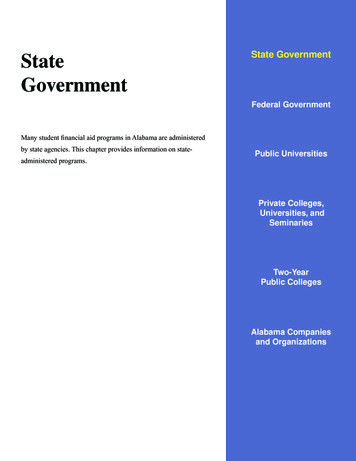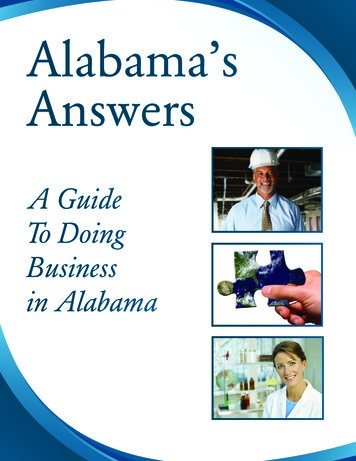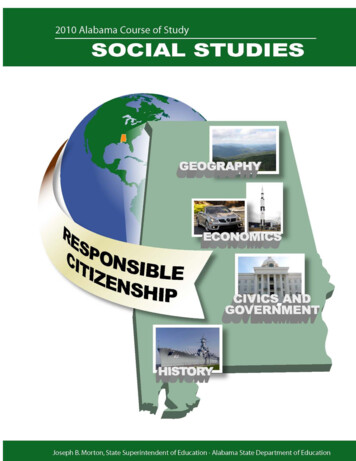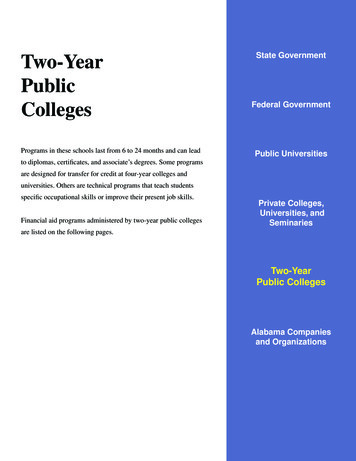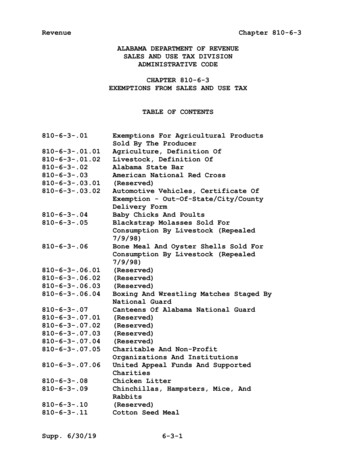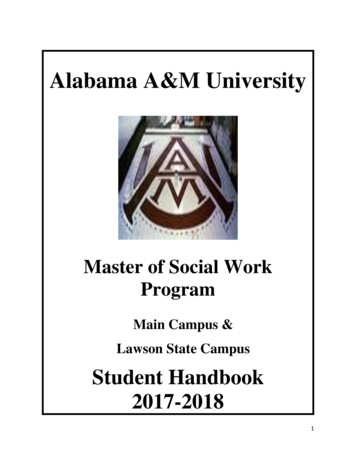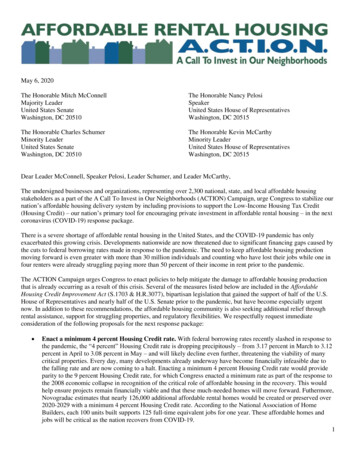
Transcription
For information regarding theAlabama Course of Study: Scienceand other curriculum materials,contact the Alabama Math, Science, and Technology Initiative (AMSTI) Section,Alabama State Department of Education,3339 Gordon Persons Building,50 North Ripley Street, Montgomery, Alabama 36104;or by mail to P.O. Box 302101, Montgomery, Alabama 36130-2101;or by telephone at (334) 353-9151.Thomas R. Bice, State Superintendent of EducationAlabama State Department of EducationThe Alabama State Board of Education and the Alabama State Department of Education do not discriminate on thebasis of race, color, disability, sex, religion, national origin, or age in its programs, activities, or employment andprovide equal access to the Boy Scouts and other designated youth groups. The following person is responsible forhandling inquiries regarding the nondiscrimination policies: Title IX Coordinator, Alabama State Department ofEducation, P.O. Box 302101, Montgomery, AL 36130-2101, telephone (334) 242-8165.
Alabama Course of StudyScienceThomas R. BiceState Superintendent of EducationALABAMA STATE DEPARTMENT OF EDUCATION
STATE SUPERINTENDENTOF EDUCATION’S MESSAGEMEMBERSof theALABAMA STATE BOARDOF EDUCATIONDear Educator:Our vision is “Every Child a Graduate—EveryGraduate Prepared!” To be prepared for collegeand career in the twenty-first century, it is essentialthat students have access to a high-quality, solidscience education. A great number of personal andsocietal issues require citizens to be scientificallyliterate and able to make informed decisions basedon an understanding of science and technology. Inaddition, today’s workforce depends on graduateswho are prepared with necessary scientific andtechnological skills to address these issues. Ournewly developed science standards affirm theimportance of science literacy for all students.The science standards reflect theinterconnectedness of the nature of science asexperienced in the real world. Science conceptsbuild coherently in depth and rigor acrossGrades K-12 as students focus on deeperunderstanding and application of content. Thestandards in the course of study represent theminimum content required to prepare students forcollege, career, and citizenship.The Alabama State Science Course of StudyCommittee and Task Force developed what Ibelieve to be a superior set of standards thatintegrate interdisciplinary teaching and learning toguide local school systems in creating localcurriculum for implementation in the schools. Byusing this new course of study as the foundation forwhat students should know and be able to do,students in the state of Alabama can meet the goalof graduating with the knowledge and skills thatwill enable them to succeed in post-high schooleducation and the workforce.Governor Robert J. BentleyPresident of the State Board of EducationDistrictIIIMatthew S. Brown, J.D.Betty PetersIIIStephanie W. BellIVYvette Richardson, Ed.D.VElla B. BellVice PresidentVIVIICynthia Sanders-McCarty, Ph.D.Jeffery NewmanPresident Pro TemVIIIMary Scott HunterState SuperintendentThomas R. BiceSecretary and Executive OfficerThomas R. BiceState Superintendent of Education2015 Alabama Course of Study: Scienceii
Alabama Course of Study: ScienceTable of ContentsPREFACE. ivACKNOWLEDGMENTS . vGENERAL INTRODUCTION . 1CONCEPTUAL FRAMEWORK . 2POSITION STATEMENTS . 4LEARNING PROGRESSIONS . 11STRUCTURE OF THE STANDARDS . 12DIRECTIONS FOR INTERPRETING THE MINIMUM REQUIRED CONTENT . 13MINIMUM REQUIRED CONTENTGRADES K-2 OVERVIEW . 15Grade K . 16Grade 1 . 18Grade 2 . 20GRADES 3-5 OVERVIEW . 22Grade 3 . 23Grade 4 . 26Grade 5 . 29GRADES 6-8 OVERVIEW . 32Grade 6 – Earth and Space Science . 33Grade 7 – Life Science . 36Grade 8 – Physical Science . 39GRADES 9-12 OVERVIEW . 42Physical Science. 43Biology. 46Chemistry . 49Physics . 52Human Anatomy and Physiology . 55Earth and Space Science . 58Environmental Science . 61APPENDIX A. Literacy Standards for Grades 6-12:History/Social Studies, Science, and Technical Subjects. 64APPENDIX B. Alabama High School Graduation Requirements . 70APPENDIX C. Guidelines and Suggestions for Local Time Requirementsand Homework . 71BIBLIOGRAPHY . 732015 Alabama Course of Study: Scienceiii
PREFACEThe 2015 Alabama Course of Study: Science provides the framework for the K-12 science educationprogram in Alabama’s public schools. Content standards in this document are minimum and required(Code of Alabama, 1975, §16-35-4). They are fundamental and specific, but not exhaustive. Whendeveloping a local curriculum, each school system may include additional content standards that focus onlocal resources and needs. Implementation strategies and external resources may also be added toenhance student learning of science in Alabama schools.The 2012-2015 Alabama State Science Course of Study Committee and Task Force reviewed theAlabama Course of Study: Science (Bulletin 2005, No. 20) and the 2012 National Research Council(NRC) publication, A Framework for K-12 Science Education: Practices, Crosscutting Concepts, andCore Ideas, in developing the minimum required content that integrates scientific concepts and scientificand engineering practices. In addition, committee members read articles in professional journals andmagazines, examined similar documents from other states, and studied national evaluations of statestandards. Members reviewed suggestions from interested individuals and groups throughout Alabama,used each member’s academic and experiential knowledge, and discussed each issue and standard amongthemselves. As a result, this document represents the scientific knowledge and practices necessary toprovide graduates with scientific and engineering literacy for success in college, career, and citizenship.The main goal of the Alabama course of study for science is to give all Alabama students a solidfoundation in science and engineering. This course of study includes the most current scientific andengineering practices, cross-cutting concepts, and disciplinary core ideas our students need in order tobecome college and career ready. Providing the K-12 students of Alabama with a foundationalunderstanding of scientific theories and laws will enable them to excel in the scientific discoveries of thefuture. Scientific theories are developed from observations and evidence to explain the nature ofphenomena, to predict future outcomes, and to make inferences about the past. Scientific laws aresupported by replicable experiments from within a controlled environment. Both theories and laws haveequivalent utility and are open for revision in light of new evidence. The theory of evolution has a role inexplaining unity and diversity of life on earth. This theory is substantiated with much direct and indirectevidence. Therefore, this course of study requires our students to understand the principles of the theoryof evolution from the perspective of established scientific knowledge. The committee recognizes andappreciates the diverse views associated with the theory of evolution.2015 Alabama Course of Study: Scienceiv
ACKNOWLEDGMENTSThis document was developed by the 2012-2015 Alabama State Science Course of Study Committee andTask Force composed of early childhood, intermediate school, middle school, high school, and collegeeducators appointed by the Alabama State Board of Education and business and professional personsappointed by the Governor (Code of Alabama, 1975, §16-35-1). The Committee and Task Force beganwork in March 2012 and submitted the document to the Alabama State Board of Education for adoptionat the August 2015 meeting.2012-2015 Alabama State Science Course of Study Committee and Task ForceDaniel Boyd, Ph.D., Chairperson, Superintendent, Lowndes County Board of EducationAngela Adams, Teacher, Union Springs Elementary School, Bullock County Board of EducationTommie R. Blackwell, Ph.D., Senior Vice President (retired), U.S. Space and Rocket Center, HuntsvilleLinda Boostrom, Instructional Support Teacher, Spain Park High School, Hoover City Board ofEducationJean W. Broom, Teacher, Holtville Elementary School, Elmore County Board of EducationLaRhonda C. Brown, Teacher, William J. Christian Alternative School, Birmingham City Board ofEducationPaula Bruno, Teacher, Pinecrest Elementary School, Sylacauga City Board of EducationJohn E. Burkhalter, Ph.D., Professor Emeritus, Auburn UniversityMary K. Busbee, Teacher, St. Clair County High School, St. Clair County Board of EducationWilliam Castlen, U.S. Air Force (retired), The Boeing Company (retired), DothanPatricia B. Davis, High School Support Teacher, Birmingham City Board of EducationJessica Franklin, Teacher, Spanish Fort Elementary School, Baldwin County Board of EducationMark Gilbert, Teacher, Alabama Clinical Schools, BirminghamLauren Hall, Instructional Support Teacher, Spain Park High School, Hoover City Board of EducationQuincy Hamilton, Teacher, Julian Harris Elementary School, Decatur City Board of EducationMarla R. Hines, Teacher, Vestavia Hills High School, Vestavia Hills City Board of EducationJean T. Howard, Principal, East Lawrence Elementary School, Lawrence County Board of EducationGretta Kilgore, Teacher, Clements High School, Limestone County Board of EducationRonald W. Kirkland, Consultant Engineer, Johnson Contractors, Inc., TuscumbiaElizabeth C. Little, Elementary Science Supervisor, Mobile County Board of EducationWilliam Lovrich, Teacher, Rehobeth Middle School, Houston County Board of EducationUrsula Martin, Technology Resource Teacher, Mobile County Board of EducationTandra Masters, Special Education/Resource Teacher, York West End Junior High School, SumterCounty Board of Education2015 Alabama Course of Study: Sciencev
William J. McAleer, (retired), McAleer Associates, Inc., MobileAmy S. McCrory, Principal, Monroeville Elementary School, Monroe County Board of EducationTina McKenzie, Teacher, Endeavor Elementary School, Madison County Board of EducationConnie L. Miller, Teacher, Oakman High School, Walker County Board of EducationJames A. Miller, Ph.D., Professor, The University of Alabama in HuntsvilleAlfred C. Nichols, Ph.D., Professor, Jacksonville State UniversityMarilyn Norsworthy, Teacher, Highland Home School, Crenshaw County Board of EducationMonica Ousley, Teacher, Billingsley School, Autauga County Board of EducationMelody Russell, Ph.D., Associate Professor, Auburn UniversityKasey L. Shelton, Teacher, Moulton Middle School, Lawrence County Board of EducationGeorge W. Smith, Consultant (retired), Bush Hog, SelmaJoAnn Smoot-Goodwin, Teacher, Kinterbish Junior High School, Sumter County Board of EducationSinikka Smothers, Ed.D., Teacher, Alabama School for the Blind, Alabama Institute for the Deaf andBlindChaRissa Stephens, Teacher, Emma Sansom Middle School, Gadsden City Board of EducationBrenda Terry, Executive Director, Alabama Mathematics, Science, Technology, and EngineeringCoalition (AMSTEC), DecaturShawn Wade, Ph.D., Teacher, George Washington Carver High School, Birmingham City Board ofEducationDeltonya Warren, Director, Instruction/Assessment, Eufaula City Board of EducationAppreciation is extended to LaJoyce Debro, Ph.D., Jacksonville State University; Sandra Enger, Ph.D.,The University of Alabama in Huntsville; M. Jenice Goldston, Ph.D., The University of Alabama;David C. Kopaska-Merkel, Ph.D., Geological Survey of Alabama; Neil Lamb, Ph.D., HudsonAlphaInstitute for Biotechnology; Lee Meadows, Ph.D., The University of Alabama at Birmingham; JustinSanders, Ph.D., University of South Alabama; Christine Schnittka, Ph.D., Auburn University; andLaura Weinkauf, Ph.D., Jacksonville State University, who served as content reviewers of thisdocument.State Department of Education personnel who managed the development process were:Thomas R. Bice, Ed.D., State Superintendent of Education;Sherrill W. Parris, Deputy State Superintendent of Education, Division of Teaching and Learning;Julie P. Hannah, Ed.D., Director, Office of Student Learning;Cynthia C. Brown, Director (retired), Standards/Courses of Study and Textbooks;Steve Ricks, Director, Alabama Math, Science, and Technology Initiative; andSusan B. Davis, Ed.D., Administrator, State Courses of Study Committees, Alabama Math, Science, andTechnology Initiative.2015 Alabama Course of Study: Sciencevi
The State Department of Education content specialists who assisted the Committee and Task Force indeveloping the document were:Robin Nelson, Program Coordinator, Instructional Services; andMichal Grant Robinson, Ed.D., Education Specialist, Instructional Services.State Department of Education process specialists who assisted the Committee and Task Force indeveloping the document were:Martha Anne Allison, Education Administrator, Alabama Math, Science, and Technology Initiative;Mylinda Brown, Ed.D., Education Specialist, Career and Technical Education;Nan Burgess, Ed.D., Education Administrator, Career and Technical Education;Jacob Davis, Education Administrator, Career and Technical Education;Martin Dukes, Education Specialist, Instructional Services;Chris Kennedy, Ed.D., Education Administrator, Career and Technical Education;Sandy Ledwell, Ed.D., Education Administrator, Alabama Math, Science, and Technology Initiative;J. Steve McAliley, Education Specialist, Alabama Reading Initiative;Jennifer McCrary, Education Administrator, Alabama Math, Science, and Technology Initiative;Ginger Montgomery, Education Specialist (retired), Curriculum;Paul Norgaard, Ph.D., Education Specialist, Alabama Math, Science, and Technology Initiative;Phyllis W. Rase, Education Specialist, Alabama Reading Initiative;Nancy M. Ray, Education Specialist, Instructional Services;Amanda Rylant, Education Specialist, Alabama Math, Science, and Technology Initiative; andSara B. Wright, Education Administrator (retired), Instructional Services.Asia Harrison, Administrative Assistant, Alabama Math, Science, and Technology Initiative, andNatasha D. Sims, Administrative Assistant (retired), Alabama Math, Science, and Technology Initiative,assisted with the preparation of the document.Charles Creel, Graphic Arts Specialist, Communication Section, assisted in the development of thegraphic design.Susan J. Blankenship, Education Specialist (retired), Alabama State Department of Education, editedand proofread the document.2015 Alabama Course of Study: Sciencevii
ALABAMA COURSE OF STUDY: SCIENCEGENERAL INTRODUCTIONIn response to our nation’s declining competitiveness in the science, technology, engineering, and mathematics(STEM) fields, the National Research Council (NRC) published a research-based report on teaching andlearning science in a 2012 document titled A Framework for K-12 Science Education: Practices, CrosscuttingConcepts, and Core Ideas. This document proposes a new approach to K-12 science education through theintegration of engineering design and engineering practices within the context of science content instruction.Supported by the NRC framework and our state’s College- and Career-Readiness (CCR) Anchor Standards forReading and for Writing (Appendix A), the goal of Alabama’s K-12 science education standards is scientificand engineering literacy for all Alabama students. The 2015 Alabama Course of Study: Science defines theminimum required content that students should master to achieve this goal.Since the present goal of Alabama’s science education curriculum includes engineering literacy, it is importantto define what is meant by the terms science, technology, and engineering. Science is the process of building astructured body of knowledge about the natural world delineated in the three traditional domains of physical,life, and earth and space sciences. Technology is defined as any modification of the natural world made tofulfill human needs or desires, thus expanding the interpretation of technology far beyond computers andelectronic devices to include simple machines, steam engines, and musical instruments. Engineering, in a broadsense, involves engagement in a systematic practice of design in order to solve problems and generate productsrising from human needs and wants. A major conceptual shift in K-12 science and engineering educationincludes a limited number of disciplinary core ideas in four domains that students explore with increasing rigorand depth over multiple years and the integration of such knowledge with the practices needed to engage inscientific inquiry and engineering design.Scientific and engineering literacy enables students to become critical thinkers and informed decision makers inan increasingly technological society. While providing students with foundational knowledge of the core ideasof physical, life, and earth and space sciences, the 2015 Alabama Course of Study: Science will also helpstudents develop competency in a specific set of engineering practices they can apply in everyday problemsolving situations. Developmentally appropriate engineering projects, beginning in kindergarten, provide ameaningful and relevant context in which students’ knowledge and skills can be applied. Engineering projectsshould include all components of the engineering design process, including specific criteria for success andconstraints on materials, time, and cost.The structure of the Alabama course of study in science reflects the approach outlined by NRC’s framework.The 2015 Alabama Course of Study: Science incorporates the three dimensions around which K-12 science andengineering education are built. These dimensions are scientific and engineering practices; crosscuttingconcepts that unify the study of science through their common application across all domains of science andengineering; and disciplinary core ideas in the physical, life, and earth and space sciences, and in engineering,technology, and applications of science.Alabama’s K-12 science program places emphasis on the importance of teaching science every day to everystudent in every grade. This document provides foundational knowledge and learning progressions that arecoherent, vertically aligned, and increasingly rigorous in preparing scientifically literate citizens with the abilityto evaluate the quality of science information and make informed personal choices, to gain an appreciation ofscience as a way of knowing about the world, and to be savvy science consumers. Effective implementation ofthe 2015 Alabama Course of Study: Science will help develop confident and capable graduates, the key toAlabama’s economic productivity and our nation’s competitiveness in the global marketplace.2015 Alabama Course of Study: Science1
2015 Alabama Course of Study: Science2
ALABAMA’S K-12 SCIENCE CURRICULUMCONCEPTUAL FRAMEWORKThe goal of Alabama’s K-12 science standards, as shown across the top of the conceptual frameworkgraphic design on page 2, is the achievement of scientific and engineering literacy by all students. Ascientifically literate person is one who has a foundation in scientific knowledge, a technologicalunderstanding of problem solving, and the ability to design scientific solutions. The correlation amongthese aspects of scientific literacy is depicted in the conceptual framework, which illustrates the threebasic dimensions for establishing scientific and engineering literacy—scientific and engineering practices,crosscutting concepts, and disciplinary core ideas.To face the many challenges of a universal society, Alabama students should be provided everyopportunity to achieve scientific and engineering literacy from a global perspective as indicated by theimage of Earth to the right of the goal statement. The infusion of a global science perspective intoAlabama’s curriculum is accomplished through a study of the three dimensions of science—scientific andengineering practices, crosscutting concepts, and disciplinary core ideas. Scientific and engineeringpractices are a set of skills and tools used by students to investigate, construct models, design and buildsystems, and develop theories about the world in which they live. Crosscutting concepts are unifyingthemes that link scientific and engineering ideas across all domains of science. Disciplinary core ideas inthe four domains of Physical Sciences; Life Sciences; Earth and Space Sciences; and EngineeringTechnology, and Applications of Science are broad concepts that provide students with foundationalknowledge. The three dimensions are depicted on the arrows that flow from the globe to the image of thestate of Alabama where they are incorporated into the four domains that form the organizational structurefor the content standards in this document.The domains of Earth and Space Sciences; Physical Sciences; Life Sciences; and Engineering,Technology, and Applications of Science are displayed in the four quadrants in the graphic of the state ofAlabama. The domain of Earth and Space Sciences is represented by a rocket, the image of an atomcharacterizes the Physical Sciences domain, and the gulf coastal area of the state symbolizes the LifeSciences domain. In the fourth quadrant are gears representing the meshing of the Engineering,Technology, and Applications of Science domain into each of the other domains. Each of the domainsaddresses the specific disciplinary core ideas of Dimension 3 as identified on page 12 of this document.Core ideas are the organizers for the content in each grade or course. However, the core ideas for thedomain of Engineering, Technology, and Applications of Science are integrated into the content standardsof the other three domains. The four domains continue from kindergarten through high school withconcepts increasing in depth and rigor as students focus on deeper understanding and application ofcontent.The resulting science standards contained in this document ensure that Alabama students, havingcompleted the K-12 science study, are informed science citizens and prepared college- and career-readygraduates. Having met the goal of attaining scientific and engineering literacy, these students will be ableto achieve success in the global society of the twenty-first century and make meaningful contributions to adynamic world.2015 Alabama Course of Study: Science3
POSITION STATEMENTSAssessmentAssessment refers to the processes used to measure student progress and achievement by identifyingpatterns of qualitative and quantitative learning driven by instruction and feedback. Assessments provideevidence of students’ prior knowledge, thinking, or learning in order to evaluate what students understandand how they are thinking at a given point in time for the purpose of promoting student learning.Consequently, science instruction should be informed by assessment, and instructional strategies shouldbe adjusted based on feedback to meet the individual needs of all students. Assessment is aligned withcurriculum and instruction and supports conceptual understanding with a focus on competency. Becauseno single assessment method provides a complete picture of what a student knows and can do, a variety ofassessment methods is imperative. Ongoing formative assessments provide diagnostic feedback toteachers and students before, during, and after instruction. Formative assessment information should beused as feedback to modify teaching and learning activities. Summative assessments are used inclassrooms, schools, and districts to determine student achievement at the end of a unit, course, or timeperiod. Designers of assessments should consider the diverse backgrounds and different learning styles ofstudents when planning for academic success in the classroom. Assessment tasks must integrate the threedimensions of science and engineering practices, crosscutting concepts, and disciplinary core ideas andprovide opportunities for students to demonstrate conceptual understanding of science phenomena duringinquiry. The primary goal of assessment is to measure with accuracy and validity what a student knowsand can do and what a student still needs to learn based on Alabama’s College- and Career-ReadinessStandards.Classroom EnvironmentEffective science classroom environments are those in which teachers and students work collaboratively.These student-centered environments shift the focus from the teacher to the learner, providingopportunities for creative scientific exploration and engineering design that allow students to connect theclassroom to the outside world. Thus, stimulating the learner’s interest in science through investigationencourages a lifelong pursuit for exploration and knowledge. The science classroom is any place wherescientific inquiry occurs, whether it is the traditional laboratory or classroom, a playground, a sciencemuseum, an amusement park, a forest, or a beach. In the student-centered classroom, emphasis is placedupon active and cooperative learning environments where students work together to manipulate variables,make observations, and use prior knowledge to construct reasonable explanations while solving problemsunder conditions that assure both positive interdependence and individual accountability. Teachers guideand facilitate investigations by immersing students in scientific practices using inquiry, correct andappropriate manipulative techniques, and safe and humane laboratory practices. Students may beobserved engaging in interpreting scientific data collected to construct and evaluate evidence-basedarguments of phenomena during scientific inquiry or engaging in argument from evidence acquiredduring research of a phenomenon. Quality science instruction emphasizes critical thinking andinvestigative processes that reveal consistencies, relationships, and patterns. The classroom should beflexible, yet structured, intellectually challenging, positive and nonthreatening, stimulating, and adaptableto a variety of learning styles.2015 Alabama Course of Study: Science4
Cultural DiversityCultural diversity is an asset in the classroom. Educators should actively encourage students of variousbackgrounds to share their experiences in relation to science. Recognizing multicultural diversity in theclassroom as a valuable resource contributes in positive ways to collaboration and participation in sciencelearning.Science and engineering are collaborative social processes that take place in the context of culturallyvalued knowledge and practices. Throughout history, diverse groups of people from different culturesand races have contributed to the body of scientific knowledge. This knowledge has resulted inremarkable technological advances
The 2012-2015 Alabama State Science Course of Study Committee and Task Force reviewed the Alabama Course of Study: Science (Bulletin 2005, No. 20) and the 2012 National Research Council (NRC) publication, A Framework for K-12 Science Education: Practices, Crosscutting Concepts, and Core Ideas, in

